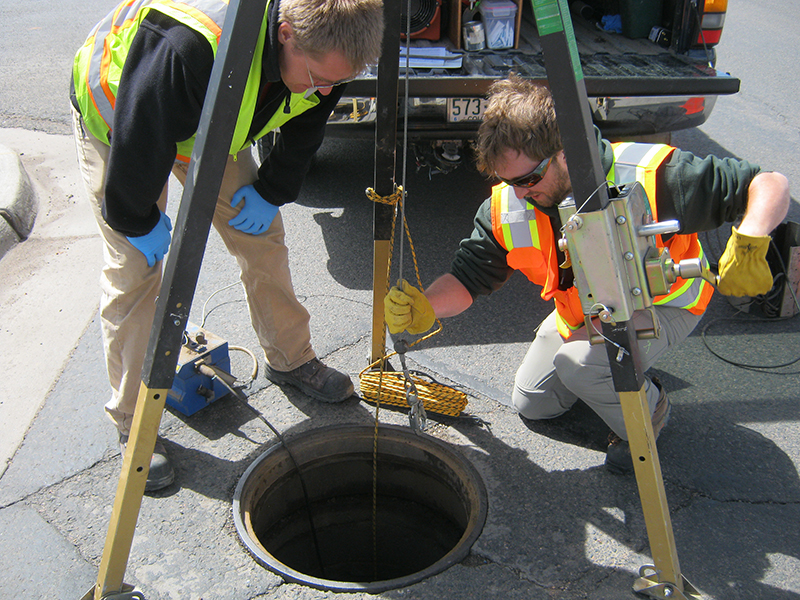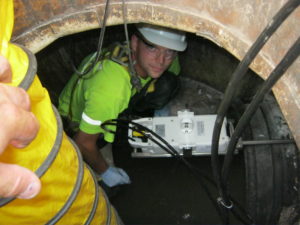Sewer Monitoring Shows the Way to Savings
 Sewer flow monitoring helps communities precisely determine whether their wastewater piping is right-sized, what effect proposed development will have on flows, and exactly where leaks might be causing problems.
Sewer flow monitoring helps communities precisely determine whether their wastewater piping is right-sized, what effect proposed development will have on flows, and exactly where leaks might be causing problems.
Monitoring involves placing a sensor into the wastewater flow. The sensor measures the depth and velocity and uses those parameters to calculate the flow rate. Sensors are placed in the sewer pipes, and a data collector is hung near the top of a manhole. The flow data can be used to calibrate a municipality’s wastewater model, which is used to determine whether its pipes are undersized in a certain location, what pipes need replacing, or what impact a new development will have on the sewer system downstream, among other things.
Adding Accuracy
Some municipalities contract with a wastewater engineering firm to develop a sewer model that accurately simulates its wastewater collection system. While a computer model can simulate wastewater flow, the model can be inaccurate without comparing the predicted flows to actual field conditions. Cities can use the calibrated model data to go into the field to pinpoint exactly where leaks are in their systems and determine whether the leaks involve faulty manholes, broken pipes, an obstruction, or some other damage to the system. Other benefits of using a calibrated wastewater hydraulic model include finding areas where there are capacity problems and using the data to evaluate potential water efficiency programs or collection system improvements.
 In fact, municipalities can actually save money with a flow monitoring program. That’s because in some instances field data may show that sewer pipes are adequately sized, allowing deferment or elimination of capital expansion projects. Also, accurate flow data enables a city to determine the impacts of a new development on wastewater flow downstream and, as such, developers then can be compelled to pay their fair share for the upgrades required to accommodate the new growth. This can be viewed as an equitable way to distribute the costs among those who are actually creating the need. Read this article for more details on the money-saving aspect of flow monitoring.
In fact, municipalities can actually save money with a flow monitoring program. That’s because in some instances field data may show that sewer pipes are adequately sized, allowing deferment or elimination of capital expansion projects. Also, accurate flow data enables a city to determine the impacts of a new development on wastewater flow downstream and, as such, developers then can be compelled to pay their fair share for the upgrades required to accommodate the new growth. This can be viewed as an equitable way to distribute the costs among those who are actually creating the need. Read this article for more details on the money-saving aspect of flow monitoring.
In essence, better data allows a municipality to make decisions without increasing its risk. Utilities are strained to manage their assets with the lowest possible capital cost. Wastewater flow monitoring in conjunction with a calibrated hydraulic model allows a municipality to get the most benefit out of each dollar spent – and to avoid spending money on projects that are not clearly addressing a capacity or condition deficiency.
Zeroing In on Problem Areas
Often times infiltration and inflow (I/I) robs the system of capacity. Flow monitors record data continuously. The low-flow periods in the middle of the night are used to determine the amount of infiltration entering the system. Inflow is surface water (typically infill runoff) that drains into a sanitary sewer system. Analyzing flow monitor data involves looking at inflow spikes, which diverge from the system’s typical daily flow pattern. The strategic use of flow monitors can help locate the areas in a system that have the highest concentration of I/I so that officials can pinpoint and fix the problems.
Not As Smelly As You Might Think
That said, climbing into wastewater sewers isn’t a job for everyone. Foremost, safety is paramount. When conducting sewer flow monitoring, Ayres’ crew uses an air monitor to check the breathable atmosphere inside the manhole for safe levels of hydrogen sulfide, oxygen, and carbon monoxide, and to make sure there is nothing combustible. Also, a wastewater sewer doesn’t stink as much as one might expect because usually the water is moving, not stagnant. Stagnant water generates the most offensive odor, particularly when there is a lot of organic matter, grease, silt, and muck. The adage “let sleeping dogs lie” applies here. If you disturb the stagnant water, it can make the job really stink. For more on the climate in a sewer, check out this post.
If you have questions regarding sewer flow monitoring or other public utility needs, contact our municipal consulting services experts.

Post a comment: